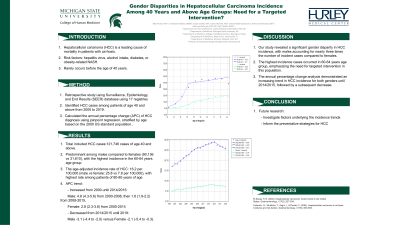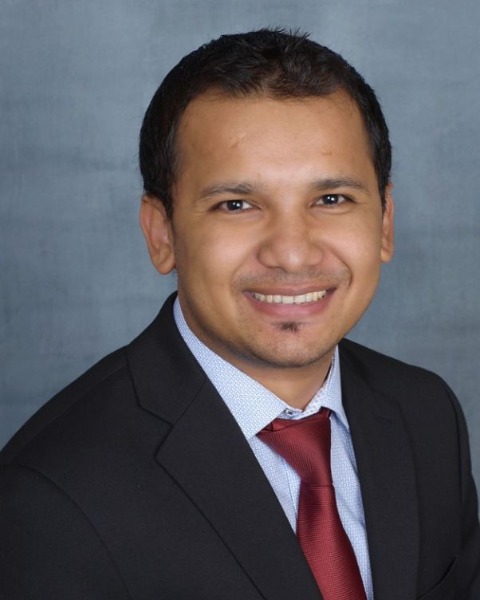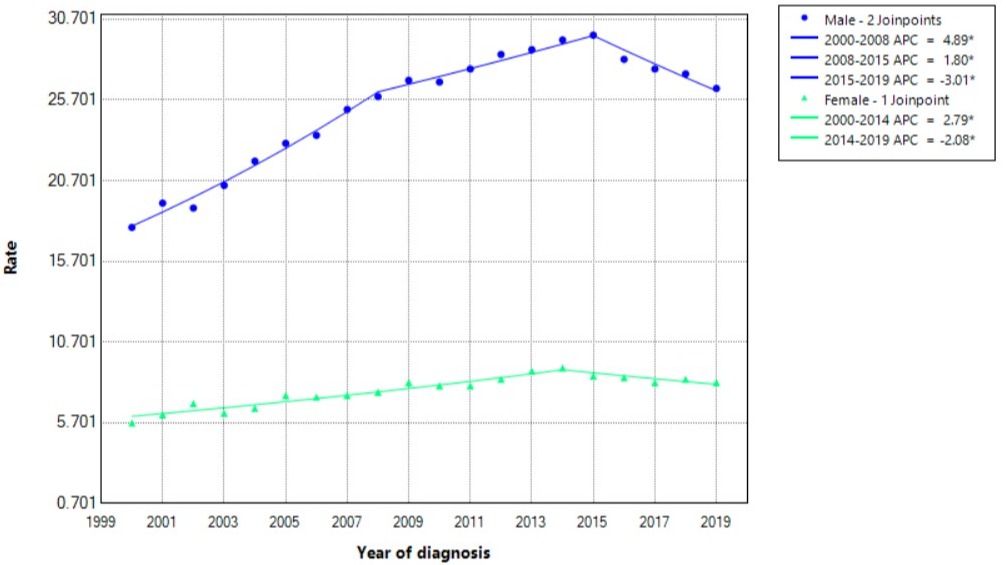Monday Poster Session
Category: Liver
P2420 - Gender Disparities in Hepatocellular Carcinoma Incidence Among 40 Years and Above Age Groups: Need for a Targeted Intervention?
Monday, October 23, 2023
10:30 AM - 4:15 PM PT
Location: Exhibit Hall

Has Audio

Bibek Karki, MD
Hurley Medical Center
Flint, MI
Presenting Author(s)
Bibek Karki, MD1, Samjhana Belbase, MBBS2, Pujan Kandel, MD3, Calvin Ghimire, MD4, Deena Abdel-Gadir, BA5, Mamoon Elbedawi, MD5, Ghassan Bachuwa, MD5
1Hurley Medical Center, Flint, MI; 2College of Medical Sciences, Kathmandu, Bagmati, Nepal; 3Mayo Clinic, Jacksonville, FL; 4Michigan State University/McLaren Flint Hospital, Flint, MI; 5Michigan State University, Flint, MI
Introduction: Hepatocellular carcinoma is a leading cause of mortality in patients with cirrhosis, with risk factors of hepatitis virus, alcohol intake, diabetes, or obesity-related NASH. It rarely occurs before the age of 40 years.
Methods: We used the Surveillance, Epidemiology, and End Results (SEER) database using 17 registries to identify hepatocellular carcinoma (HCC) cases among patients of age 40 and above from 2000 to 2019. We calculated the annual percentage change (APC) of HCC diagnosis using joinpoint regression, stratified by age based on the 2000 US standard population.
Results: We included a total of 121,746 cases of HCC of age 40 and above. The incident cases were almost three times more predominant among males (90,136 vs 31,610), with the highest incident cases in the 60-64 years age group. The age-adjusted incidence rate of HCC among patients 40 and above is 16.2 per 100,000 (male vs female: 25.8 vs 7.8 per 100,000), being highest among patients of the 80-85 years age group. The age of diagnosis percentage change increased at a higher rate until 55-60 years of age with being rate higher among males (17.5 (11.7-22.3) vs 12.9 (7.9 – 26.1)), which later increased but at a slower rate (0.7 (-0.7 – 1.6) vs 2.3 (0.2 – 4.1)). The APC for both genders increased from 2000 until 2014/2015 (male: 4.8 (4.3 – 5.6) from 2000-2008, 1.6 (1.9 – 2.2) from 2008-2015, female: 2.8 (2.3 – 3.6) from 2000-2014), which decreased from 2014/2015 until 2019 with APC of -3.1 (-4.4 to -2.0) in males versus -2.1 (-5.4 to -0.3) in females.
Discussion: Our study revealed a significant gender disparity in HCC incidence, with males accounting for nearly three times the number of incident cases compared to females. The highest incidence cases occurred in 60-64 years age group, emphasizing the need for targeted intervention in this population. The annual percent change analysis demonstrated an increasing trend in HCC incidence for both genders until 2014/2015, followed by a subsequent decrease. We need to investigate to understand the factors underlying these trends and inform the preventative strategies.

Disclosures:
Bibek Karki, MD1, Samjhana Belbase, MBBS2, Pujan Kandel, MD3, Calvin Ghimire, MD4, Deena Abdel-Gadir, BA5, Mamoon Elbedawi, MD5, Ghassan Bachuwa, MD5. P2420 - Gender Disparities in Hepatocellular Carcinoma Incidence Among 40 Years and Above Age Groups: Need for a Targeted Intervention?, ACG 2023 Annual Scientific Meeting Abstracts. Vancouver, BC, Canada: American College of Gastroenterology.
1Hurley Medical Center, Flint, MI; 2College of Medical Sciences, Kathmandu, Bagmati, Nepal; 3Mayo Clinic, Jacksonville, FL; 4Michigan State University/McLaren Flint Hospital, Flint, MI; 5Michigan State University, Flint, MI
Introduction: Hepatocellular carcinoma is a leading cause of mortality in patients with cirrhosis, with risk factors of hepatitis virus, alcohol intake, diabetes, or obesity-related NASH. It rarely occurs before the age of 40 years.
Methods: We used the Surveillance, Epidemiology, and End Results (SEER) database using 17 registries to identify hepatocellular carcinoma (HCC) cases among patients of age 40 and above from 2000 to 2019. We calculated the annual percentage change (APC) of HCC diagnosis using joinpoint regression, stratified by age based on the 2000 US standard population.
Results: We included a total of 121,746 cases of HCC of age 40 and above. The incident cases were almost three times more predominant among males (90,136 vs 31,610), with the highest incident cases in the 60-64 years age group. The age-adjusted incidence rate of HCC among patients 40 and above is 16.2 per 100,000 (male vs female: 25.8 vs 7.8 per 100,000), being highest among patients of the 80-85 years age group. The age of diagnosis percentage change increased at a higher rate until 55-60 years of age with being rate higher among males (17.5 (11.7-22.3) vs 12.9 (7.9 – 26.1)), which later increased but at a slower rate (0.7 (-0.7 – 1.6) vs 2.3 (0.2 – 4.1)). The APC for both genders increased from 2000 until 2014/2015 (male: 4.8 (4.3 – 5.6) from 2000-2008, 1.6 (1.9 – 2.2) from 2008-2015, female: 2.8 (2.3 – 3.6) from 2000-2014), which decreased from 2014/2015 until 2019 with APC of -3.1 (-4.4 to -2.0) in males versus -2.1 (-5.4 to -0.3) in females.
Discussion: Our study revealed a significant gender disparity in HCC incidence, with males accounting for nearly three times the number of incident cases compared to females. The highest incidence cases occurred in 60-64 years age group, emphasizing the need for targeted intervention in this population. The annual percent change analysis demonstrated an increasing trend in HCC incidence for both genders until 2014/2015, followed by a subsequent decrease. We need to investigate to understand the factors underlying these trends and inform the preventative strategies.

Figure: Gender variation of age-adjusted incidence rate of hepatocellular carcinoma with year of diagnosis
Disclosures:
Bibek Karki indicated no relevant financial relationships.
Samjhana Belbase indicated no relevant financial relationships.
Pujan Kandel indicated no relevant financial relationships.
Calvin Ghimire indicated no relevant financial relationships.
Deena Abdel-Gadir indicated no relevant financial relationships.
Mamoon Elbedawi indicated no relevant financial relationships.
Ghassan Bachuwa indicated no relevant financial relationships.
Bibek Karki, MD1, Samjhana Belbase, MBBS2, Pujan Kandel, MD3, Calvin Ghimire, MD4, Deena Abdel-Gadir, BA5, Mamoon Elbedawi, MD5, Ghassan Bachuwa, MD5. P2420 - Gender Disparities in Hepatocellular Carcinoma Incidence Among 40 Years and Above Age Groups: Need for a Targeted Intervention?, ACG 2023 Annual Scientific Meeting Abstracts. Vancouver, BC, Canada: American College of Gastroenterology.
